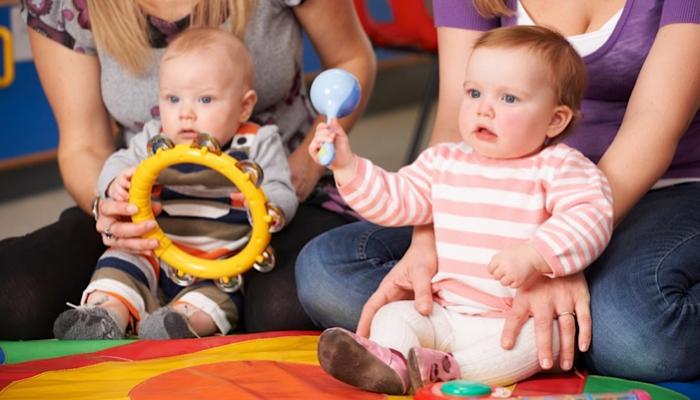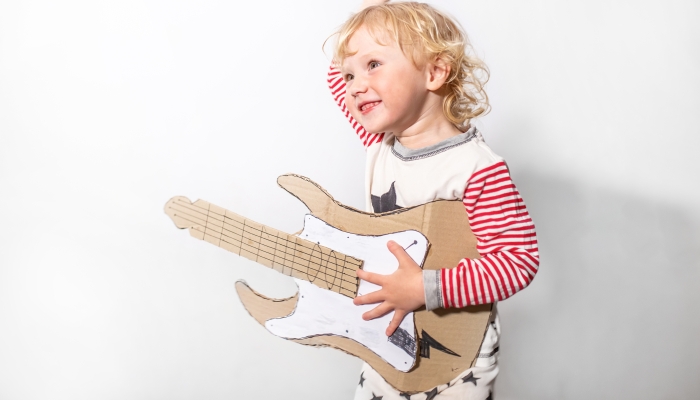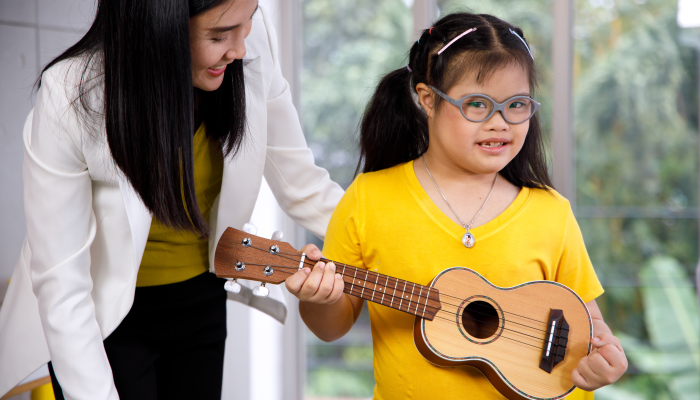Babies & Music: How to introduce your infant or young child to music

This post may contain affiliate links; please see our terms of use for details.
When is the right time to introduce your infant or young child to music?
Although the youngest baby or infant, can’t yet talk, walk, or communicate, it is clear to their parents that they are responding to their environment, no matter what their abilities may be. All babies are learning, growing, and taking in what is around them in their own special way.
As a parent, you can use music as one of the best tools to connect, enrich, and bond with your baby or young child. In a nutshell, it is never too early to bring music into your lives as enrichment, therapy, or just plain fun!
And, the truth of the matter is that you’ve already begun! Even while your baby was still in the womb, they’ve basked in the beauty of your voice and moved to the rhythm of your heartbeat. Without even knowing it, you’ve probably already opened their world to the wonder of sound. Now it’s just a matter of building on that great start and exploring more ways that baby and the whole family can enjoy and share some musical fun.
Your Voice is Music to My Ears!
Even if you weren’t actually singing to your baby before birth, your voice was still a large part of his first memories of being alive and aware. Talking and singing to your baby or young child strengthens the bond between parent and child and connects your lives as well as expands their brains. For babies without sight this sound connection is even more important.
If you like to sing and enjoy your voice, that’s great! Your baby will love to hear anything that you have to sing! Don’t discount even the simplest songs or soothing talk as important in communicating with your little one. If you don’t feel you have a glorious voice—don’t worry!—there will always be something special and unique in a loved one’s voice that reaches the deepest places in your child’s heart.
Try to sing, sing-speak, or even pick out music you like and sing along with it. Your child will respond to the care and attention, so feel comfortable experimenting with your baby as your own private audience. Just relax and have fun with it. You might be surprised at how good you sound!
Feel The Beat
 So now your baby is getting a regular dose of sound. Spoken words, musical tones, and sounds like dogs barking, birds singing, and cell phones ringing are awakening their ears and being catalogued in their young brains. At the same time, they have already developed a sense of rhythm.
So now your baby is getting a regular dose of sound. Spoken words, musical tones, and sounds like dogs barking, birds singing, and cell phones ringing are awakening their ears and being catalogued in their young brains. At the same time, they have already developed a sense of rhythm.
Studies of young babies show that they can tell right away when a beat is missed in a pattern so they are keenly aware of the ebb and flow of sound around them. Remember, during the first nine months, the pattern of the human heartbeat served as deeply comforting music that became the soundtrack to their first months of life.
With that in mind, don’t discount the time you spend simply snuggling with your little one or comforting them by holding them close to your heart as a way to help them connect with the inner rhythms of their own being—not to mention relaxing them for naps or bedtime.
If you prefer something a little more elaborate, you may also want to play relaxing music from world music traditions as many of them are patterned after mom’s heartbeat. Along with adding some new musical flavors to your life, beautiful music can also serve to restore and renew moms, caregivers, and young infants giving everyone a much-needed rest.
A Quiet Place for You and Me
In the hectic time after a new baby is born, especially if you’re dealing with a new diagnosis and numerous medical appointments, music can be amazingly powerful in creating a space for both relaxation and expression. Whether you have a formal naptime, use it as bedtime music, background music, or sing along to favorite music while cruising through chores, it’s something that can make you feel refreshed and more resilient during this demanding time in your life.
What can you listen to? Check out some new tunes. Libraries are a great source for borrowing and exploring new music without having to purchase each new selection. You can also sample and download music from iTunes, CD Baby, or Amazon, looking under such categories as meditation, relaxation, new age, piano instrumental, harp music, lullabyes, etc. You can also check out children’s music and find some new artists whose styles fit your tastes.
And what about your old favorites? Definitely dig up the music you enjoy the most. I often find that new parents like to reconnect with music from their younger days to share with their little ones. What songs or music carry the best memories or inspiration for you? It’s great to incorporate them into your new baby’s young life as well.
Sing a Song About Me!
When you’re ready to start singing a bit more you can dig up many of the favorites you probably heard as a kid. Everyone knows the basic children’s songs… “Twinkle, Twinkle Little Star”, “Oh Susannah”, “Bah, Bah, Black Sheep”. These types of songs are perfect for singing while driving in the car or to make boring tasks go faster such as folding endless laundry, mopping hallways, etc.
But here’s a great twist that anyone can do—take a song you already know and change it slightly to be about your baby or your family or something else that is unique to you. Sing “Oh Susannah” as “Oh Little David” or “My Aisha, don’t you cry for me…” Bah, Bah, Black Sheep is fun to sing using the color of a baby’s clothing as part of the song. And who says that “My Bonnie Lies Over the Ocean”, really needs to be about Bonnie?
Some songs require a bit of finesse with the length or sounds in your child’s name—but it isn’t rocket science. With a bit of clever adjustment, you can have a whole assortment of songs that are custom-suited to tell the tales of your family’s adventures. Perhaps your new songs won’t make it to the Grammies, but they will easily make it into the top ten of your children’s daily playlist!
Look below for more examples on how to personalize songs for your family.
Shake, Rattle, and Roll and Let Your Fingers Do the Walking!
 In the same way that making up new songs can be easy and fun, you can also feel free to experiment with simple finger-plays such as the classic Itsy Bitsy Spider or songs with motions that are incredibly easy to do.
In the same way that making up new songs can be easy and fun, you can also feel free to experiment with simple finger-plays such as the classic Itsy Bitsy Spider or songs with motions that are incredibly easy to do.
If your child is blind or sight-impaired, they can follow your hands as you make the motions, or you can transform the hand motions into body motions. For example, when the spider crawls up the water spout, move your fingers up your baby’s body so she can feel the spider “crawling” on her. This is usually a huge hit! Chances are good they will soon begin trying to do the motions along with you, helping to increase their motor skills!
If you can’t remember the motions to these classic songs, check out these nursery rhyme videos.
Similarly you can play simple instruments for and with your baby, making sure the instruments they have are childsafe and the parts won’t come off and be inserted into mouth or ears.
If you don’t have lots of instruments around your house or a big budget to buy new ones, make sure to visit my website to find a nice variety of things that can be made at home such as hidden treasure rattles or a simple drum made from a shoebox called a cajón.
Playing music with your child can be great fun and very relaxing, giving you time to create, express yourself, and bond with your baby at the same time.
So, during the wonderful but exhausting time when your child is an infant or a toddler, music can be one of the nicest ways to connect, play, and relax for both of you! Get creative with the process and try not to be too self-conscious. Before you know it, both of you will be singing, learning, and making beautiful music together!
Here are some fun songs to make your own…
BINGO
(insert names of family, friends, pets)
I have a sister that I love and Sarah is her name-o, S,A,R,A,H
and Sarah is her name-o, S,A,R,A,H
We have a dog in our back yard
and Alex is his name-o, A,L, E and X
and Alex is his name-o
Bah, Bah, Black Sheep
(insert the colors of clothing that your child and others are wearing)
Bah, bah, purple sheep
Have you any wool
Yes, sir, yes sir, three bags full
One for my father and my mother so dear
And one for the baby that I have over here
The Itsy Bitsy Spider
The itsy bitsy spider climbed up the water spout.
Down came the rain and washed the spider out.
Out came the sun and dried up all the rain.
And the itsy bitsy spider climbed up the spout again.
La Araña Pequenita
La araña pequeñita subió, subió, subió,
Vino la lluvia y se la llevó.
Salió el sol y todo lo secó.
Y la araña pequeñita subió, subió, subió.
My Hat
My hat it has three corners,
Three corners has my hat,
And if it didn’t have three corners,
It wouldn’t be my hat!
Award-winning children’s performer, Daria (Daria Marmaluk-Hajioannou), has five CDs that have won national honors. She has the most awesome job of traveling the world to sing for kids and peace. Her website, located at dariamusic.com, was given a 2009 Parents Choice Award for its musical and cultural content.

Related Posts

Music Play
5 Fun DIY Musical Instruments for Kids
Looking for a rainy day activity you can do on a budget? Get your little rock stars into these easy, crafty DIY musical instruments with stuff you have at home.

Autism, Music Play
6 Ways Music Therapy Can Support Children With Autism
By harnessing the power of music, autistic children can develop communication, social, emotional, cognitive, and motor skills. Here’s how!

Music Play
Music and Movement: Enhancing Preschool Learning Through Songs
Music and movement activities for preschoolers can help enhance their cognitive skills and brain development while developing social, emotional, and academic skills.